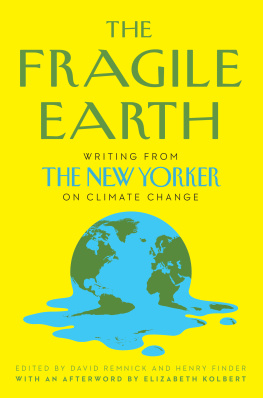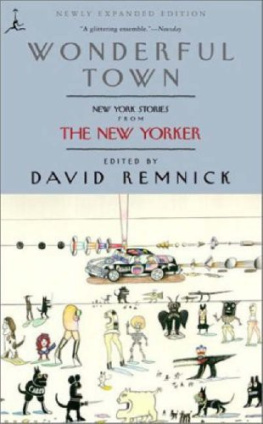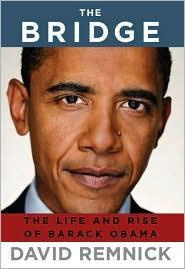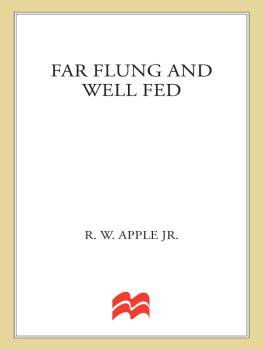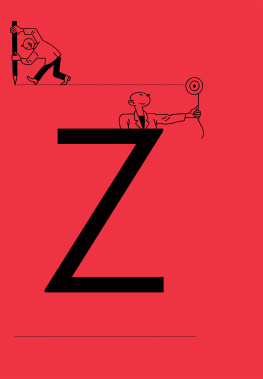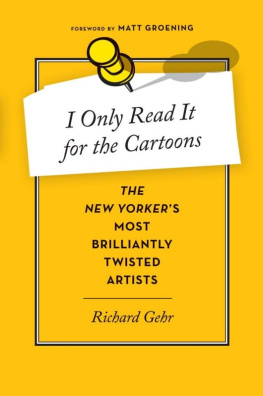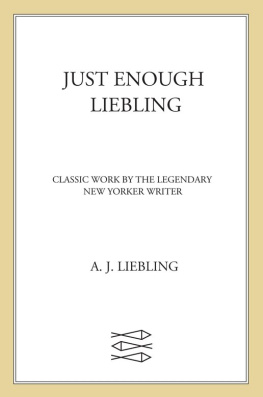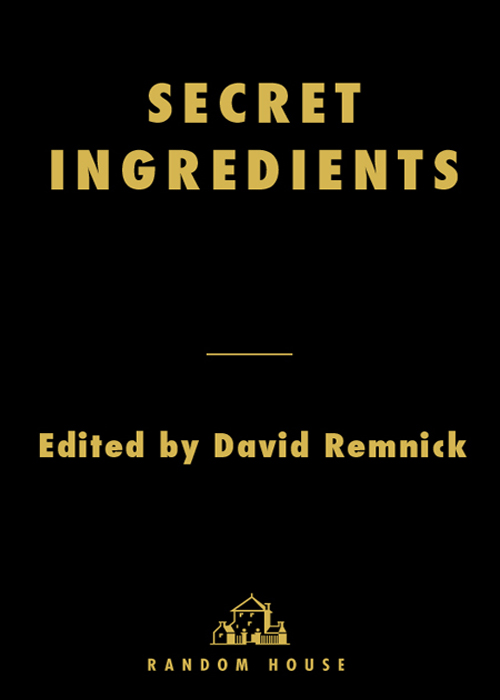
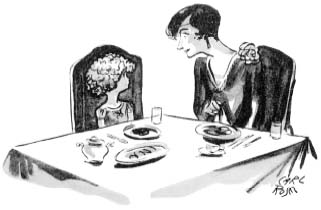
Its broccoli, dear.
I say its spinach, and I say the hell with it.
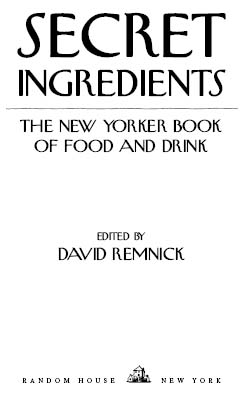
CONTENTS

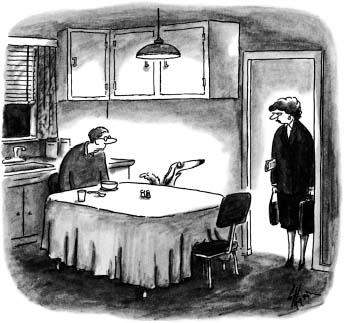
Thank goodness youre here. His dish is empty.
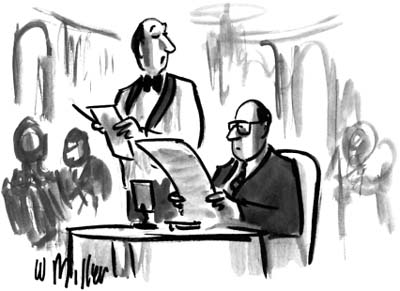
Very classy choice for a guy whos eating solo.
INTRODUCTION

DAVID REMNICK
T o his colleagues, Harold Ross, the founding editor of The New Yorker, was a tireless editorial engine fueled by a steady diet of high anxiety and unfiltered cigarettes. But while the magazine over the years employed its share of gourmands (Alexander Woollcott, A. J. Liebling), Ross himself was of circumscribed appetite. For the fun of it, he had a $3,500 stake in the famous Los Angeles hangout run by his friend Dave Chasenhe provided suggestions on everything from proofreading the menu to the optimal way to brine a turkeyand yet his own diet was abstemious. It wasnt his fault. Ross suffered from debilitating ulcers. Stress, particularly the stress of inventing The New Yorker, keeping it afloat during the Depression, and then elaborating its original principles into a literary and commercial success, was his perpetual state, warm milk and hot broth his diet. On this meager nourishment, he kept himself going. He was shambling, stooped, and in no way an athlete, yet he was strong enough for the job. As E. B. White once said, Ross was an Atlas who lacked muscle tone.
Some limited salvation came to Rosss innards when he befriended Sara Murray Jordan, a renowned gastroenterologist at the Lahey Clinic in Boston. Thanks to Dr. Jordan, Rosss ulcer pain eased somewhat and he even began to eat his share of solid foods. Rosss gut, an unerring, if pained, precinct, now provided him with yet another editorial idea: Dr. Jordan was not only a superb physician but a competent cook, and so Ross put her together with his culinary expert at the magazine, Sheila Hibben, and bid them to collaborate on a recipe compendium for the gastrointestinally challenged, to be called Good Food for Bad Stomachs. In his first bylined piece since his days as a newspaperman during the First World War, Ross contributed an introduction that began, I write as a duodenum-scarred veteran of many years of guerrilla service in the Hydrochloric War. Ross also paid tribute to Dr. Jordan, who at dinner one night urged him to pass on his usual fruit compote and to try the digestively more daring meringue glace.
Now meringue glace has a French name, which is bad, and it is an ornamental concoction, which is bad, Ross wrote. Although I regard it as essentially a sissy proposition and nothing for a full-grown man to lose his head over, I have it now and then when Im in the ulcer victims nearest approach to a devil-may-care mood.
Rosss longtime deputy and eventual successor, William Shawn, neither smoked nor drank and enjoyed relatively good health to the end of a long life, yet he, too, is recalled by his colleagues not only for his editorial intelligence and preternatural generosity but also for his curious modesty at table. At his regular lunches with writers at the Algonquin Hotel, Shawn would usually order nothing more than a slice of toasted pound cake (and barely touch it) or a bowl of cornflakes in milk (and leave the flakes floating). His interest was solely with the writer across the table.
While Ross and Shawn did not distinguish themselves as fressers, they did build a magazine that welcomed some of the greatest eaters and also some of the greatest writers about eating who have ever picked up pen or fork. This anthology comprises those men and women of appetite and their successors, writers who have taken an interest in food and drink as a source of pleasure, sustenance, metaphor, portraiture, adventure, comedy, and fiction.
A. J. Liebling, who came to the magazine in 1935 from the New York World-Telegram, was surely the first among equals in the field. Lieblings food writing was as much about memory as it was about food, and his last book, Between Meals, which appeared serially in the magazine, was a memoir about the Paris of his youth. Paris, for him, was the capital of pleasure. There would come a time, he wrote, when if I had compared my life to a cake, the sojourns in Paris would have presented the chocolate filling. The intervening layers were plain sponge.
Like so many of his models, Rabelais included, Liebling was a prodigious writerlife being short, he valued speed and volume; he used to say that he could write better than anyone who wrote faster and faster than anyone who wrote betterbut his indulgences away from the desk exacted a price. He died at the age of fifty-nine. His Times obituary remarked, Mr. Liebling bore the marks of the gourmet: an extended waistline and rosy cheeks. I used to be shy about ordering a steak after I had eaten a steak sandwich, he once said, but I got used to it.
Liebling habitually apprenticed himself to a cast of elders: in boxing to the trainer Whitey Bimstein, in writing to Camus and Pierce Egan, and, in the restaurants of Paris, to a playwright and heroic eater of his acquaintance, Yves Mirande, who often presided at a favorite restaurant on the Rue Saint-Augustin. In A Good Appetite, one of the many full plates served up here, Liebling recalls Mirandes admirable capacities and, in doing so, provides a catalogue of particulars no less vivid than Homers ships and a seminar on the virtues (however fleeting) of abandon. Mirande, Liebling wrote, would dazzle his fellow diners by dispatching a lunch of raw Bayonne ham and fresh figs, a hot sausage in crust, spindles of filleted pike in a rich rose sauce Nantua, a leg of lamb larded with anchovies, artichokes on a pedestal of foie gras, and four or five kinds of cheese, with a good bottle of Bordeaux and one of champagne, after which he would call for the Armagnac and remind Madame to have ready for dinner the larks and ortolans she had promised him, with a few langoustes and a turbotand, of course, a fine civet made from the marcassin, or young wild boar, that the lover of the leading lady in his current production had sent up from his estate in the Sologne. And while I think of it, I once heard him say, we havent had any woodcock for days, or truffles baked in the ashes, and the cellar is becoming a disgraceno more 34s and hardly any 37s. Last week, I had to offer my publisher a bottle that was far too good for him, simply because there was nothing between the insulting and the superlative.
It is unclear whether Liebling could write faster than Proust, and certainly he could not write better, but he did dare a gibe at the master by mock-wondering if perhaps
Next page

